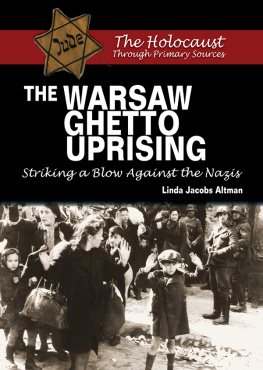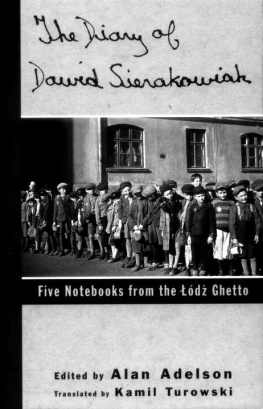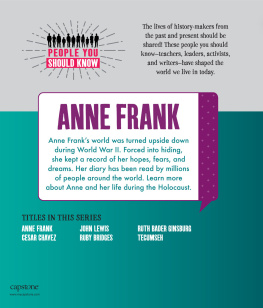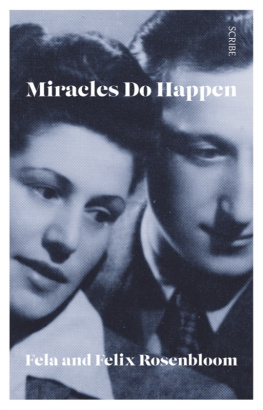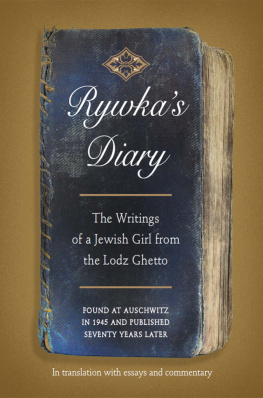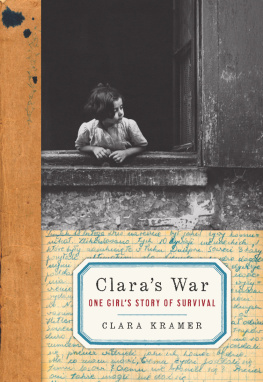Rywka Lipszyc - Rywkas Diary: The Writings of a Jewish Girl from the Lodz Ghetto
Here you can read online Rywka Lipszyc - Rywkas Diary: The Writings of a Jewish Girl from the Lodz Ghetto full text of the book (entire story) in english for free. Download pdf and epub, get meaning, cover and reviews about this ebook. year: 2015, publisher: HarperCollins, genre: Non-fiction. Description of the work, (preface) as well as reviews are available. Best literature library LitArk.com created for fans of good reading and offers a wide selection of genres:
Romance novel
Science fiction
Adventure
Detective
Science
History
Home and family
Prose
Art
Politics
Computer
Non-fiction
Religion
Business
Children
Humor
Choose a favorite category and find really read worthwhile books. Enjoy immersion in the world of imagination, feel the emotions of the characters or learn something new for yourself, make an fascinating discovery.

- Book:Rywkas Diary: The Writings of a Jewish Girl from the Lodz Ghetto
- Author:
- Publisher:HarperCollins
- Genre:
- Year:2015
- Rating:4 / 5
- Favourites:Add to favourites
- Your mark:
Rywkas Diary: The Writings of a Jewish Girl from the Lodz Ghetto: summary, description and annotation
We offer to read an annotation, description, summary or preface (depends on what the author of the book "Rywkas Diary: The Writings of a Jewish Girl from the Lodz Ghetto" wrote himself). If you haven't found the necessary information about the book — write in the comments, we will try to find it.
A work of elegant translation and painstaking contextualization by Holocaust scholars and surviving family members that sharpens the historical and spiritual lens through which its absorbed. Chicago Tribune
The newly discovered diary of a Polish teenager in the Lodz ghetto during World War IIoriginally published by Jewish Family & Childrens Services of San Francisco, now revised, illustrated, and beautifully designed
After more than seventy years in obscurity, the diary of a teenage girl during the Holocaust has been revealed for the first time. Rywkas Diary is at once an astonishing historical document and a moving tribute to the many ordinary people whose lives were forever altered by the Holocaust. At its heart, it is the diary of a girl named Rywka Lipszyc who detailed the brutal conditions that Jews in the Lodz ghetto, the second largest in Poland, endured under the Nazis: poverty, hunger and malnutrition, religious oppression, and, in Rywkas case, the death of her parents and siblings. Handwritten in a school notebook between October 1943 and April 1944, the diary ends literally in mid-sentence. What became of Rywka is a mystery. A Red Army doctor found her notebook in Auschwitz after its liberation in 1945 and took it back with her to the Soviet Union.
Rywkas Diary is also a moving coming-of-age story, in which a young woman expresses her curiosity about the world and her place in it and reflects on her relationship with Goda remarkable affirmation of her commitment to Judaism and her faith in humanity. Interwoven into this carefully translated diary are photographs, news clippings, maps, and commentary from Holocaust scholars and the girls surviving relatives, which provide an in-depth picture of both the conditions of Rywkas life and the mysterious end to her diary.
Moving and illuminating, told by a brave young girl whose strong and charismatic voice speaks for millions, Rywkas Diary is an extraordinary addition to the history of the Holocaust and World War II.
Rywka Lipszyc: author's other books
Who wrote Rywkas Diary: The Writings of a Jewish Girl from the Lodz Ghetto? Find out the surname, the name of the author of the book and a list of all author's works by series.

